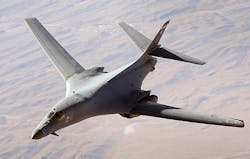Air Force asks Lockheed Martin to build three more LRASM anti-ship missile systems for high-priority targets
Officials of the U.S. Air Force Life Cycle Management Center at Eglin Air Force Base, Fla., announced a $10.3 million order Friday to the Lockheed Martin Corp. Missiles and Fire Control segment in Orlando, Fla., to build three additional LRASMs as part of Lot 2 production.
This contract is the third order for LRASM production. Lockheed Martin won a $172.1 million contract last month to build 50 LRASMs as part of Lot 2 production. Before that, Lockheed Martin won an $86.5 million contract in July 2017 to manufacture the first 23 LRASM munitions in Lot 1 production. That contract marked the first production award for the air-launched variant of the anti-ship missile for the U.S. Navy and Air Force.
LRASM is a joint project of the U.S. Defense Advanced Projects Agency (DARPA) in Arlington, Va., the Navy, and the Air Force to design an advanced anti-ship missile that can launch from the Navy F/A-18E/F Super Hornet jet fighter bomber, as well as from the Air Force B-1B Lancer long-range strategic bomber.
In the future LRASM also will launch from the F-35 Lighting II joint strike fighter, as well as from the Navy Mark 41 shipboard Vertical Launch System. The missile travels at high subsonic speeds, and likely will give way in the future to expected new generations of hypersonic missiles. Submarine-launched versions are under consideration.
Related: Raytheon moves ahead with new guidance sensor and processor for anti-ship Tomahawk missile
LRASM is designed to detect and destroy high-priority targets within groups of ships from extended ranges in electronic warfare jamming environments. It is a precision-guided, anti-ship standoff missile based on the Lockheed Martin Joint Air-to-Surface Standoff Missile-Extended Range (JASSM-ER).
Lockheed Martin has been designing LRASM for the last nine years, primarily under DARPA supervision. The advanced anti-ship missile is intended to replace the ageing Harpoon anti-ship missile. It has a multi-mode radio frequency sensor, a new weapon data-link and altimeter, and an uprated power system.
The LRASM can be guided toward enemy ships from as far away as 200 nautical miles by its launch aircraft, can receive updates via its datalink, or can use onboard sensors to find its target. LRASM will fly towards its target at medium altitude then drop to low altitude for a sea skimming approach to counter shipboard anti-missile defenses.
The LRASM uses on-board targeting systems to acquire the target independently without the presence of intelligence or supporting services like Global Positioning System (GPS) satellite navigation and data links. Lockheed Martin is designing he missile with advanced counter-countermeasures to evade hostile active defense systems.
Lockheed Martin won a $321.8 million Navy contract in 2016 to complete LRASM integration, test, and integration; incorporate an affordable and executable LRASM manufacturing process into Lockheed Martin's existing JASSM-ER production process; examine and define the logistics footprint; design for producibility; ensure affordability; add anti-tamper and cyber security; and demonstrate system integration, interoperability, safety, and utility.
In fall 2014 Lockheed Martin conducted its second LRASM flight test in a launch from an Air Force B-1B bomber off the Southern California coast. Flying over the sea range at Point Mugu, Calif., the bomber from the 337th Test and Evaluation Squadron at Dyess Air Force Base, Texas, released the LRASM, which navigated through all planned waypoints receiving in-flight targeting updates from the system's Weapon Data Link, Lockheed Martin officials say.
After switching to autonomous guidance, the LRASM identified the target using inputs from the onboard sensors, descended for final approach, verified the target, and hit it.
The Lockheed Martin LRASM has a 1,000-pound penetrator and blast-fragmentation warhead, multi-mode sensor, weapon data link, and enhanced digital anti-jam global positioning system to detect and destroy selected surface targets within groups of ships.
Lockheed Martin is in charge of LRASM overall development, and the BAE Systems Electronic Systems segment in Nashua, N.H., is developing the LRASM onboard sensor systems.
LRASM development is in response to a gap in Navy anti-ship missile technology identified in 2008. The standard Navy anti-ship missile is the subsonic Harpoon, which has been in the inventory since 1977.
Since LRASM started development a decade ago, however, hypersonic cruise missiles able to fly faster than five times the speed of sound have become one of the Pentagon's top priorities. This has the potential to limit overall LRASM production numbers.
On this contract Lockheed Martin will do its work in Orlando, Fla., and should be finished by February 2020. For more information contact Lockheed Martin Missiles and Fire Control online at www.lockheedmartin.com, or the Air Force Life Cycle Management Center at www.wpafb.af.mil/aflcmc.
Ready to make a purchase? Search the Military & Aerospace Electronics Buyer's Guide for companies, new products, press releases, and videos
